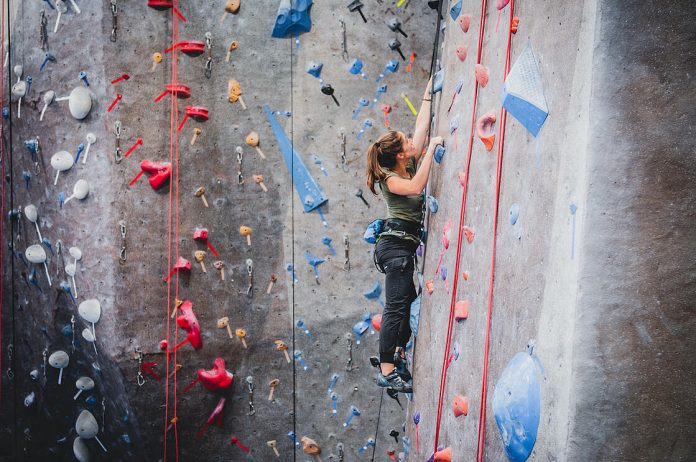Citing an “amazing” level of transparency among climbing industry professionals and a willingness to help each other figure out industry solutions to minimize the long-term impacts of the current pandemic, Head Rush Technologies has pulled together a set of suggested guidelines and actionable insights designed to help climbing gyms reopen in a safe manner.
“As we get closer to reopening, it’s clear that it’s not going to be business as usual, especially in the near future,” said Head Rush executives. “During this time, we’ve been talking to our partners around the globe, listening to CWA’s (Climbing Wall Association) informative Community Calls, testing disinfecting methods on our products and trying to support our customers however we can.”
Head Rush Technologies, a provider of equipment for climbing gyms and adventure parks, is in the unique position of having its devices installed in more than 60 countries around the world, with each country having been going through a similar set of circumstances. Below are excerpts from Head Rush’s attempt to consolidate what the global climbing community is doing in response to COVID-19, including how gyms are approaching reopening, cleaning and hygiene. The advice provides a glimpse of the procedures and precaution outdoor stores might need to put in place once lockdowns are lifted and store doors open to foot traffic.
Reopening
Of course, every gym will need to develop protocols that are comfortable for its business, customers and members. Among its recommendations, Head Rush first suggests gyms use a reservation system, if available, to control capacity and manage the check-in/waiver process. Staggering entry times would also help to avoid lines and crowding at the entrance of an establishment.
Operators also can consider dividing gyms into sections. This could include extending the distance between routes and roped areas, reducing the number of climbing lanes to promote social distancing and taping off bouldering areas to encourage giving adequate space.
Head Rush also suggests creating auto belay specific zones to minimize contact among climbers and reduce the handling of equipment. “By creating a dedicated auto belay area, climbers can not only climb at a distance from each other but also maximize time on the wall for training,” said Head Rush. “With strategic auto belay placement and routesetting, gyms can provide enough space to ensure climbers feel sage and make the most of gym time.”
Gym operators also should look to set routes in a way that make customers feel comfortable, such as by reducing density of routes and taping off, or otherwise marking, climbing lanes.
It’s also worth considering having participants sign COVID-specific waivers that outline the steps a gym is taking to mitigate risks. Information in the waiver can be included on a gym’s website to help set expectations before climbers arrive. Education of customers on an establishments efforts should continue on-premises, such as through posters and signage installed around the gym to eliminate any confusion. The CDC, for one, provides free downloadable print materials filled with health and safety information to support COVID-19 procedures and recommendations.
“Communicate what you’re doing so that your customer base will feel comfortable coming back to the gym,” Head Rush executives advised.
Hygiene
When it comes to hygiene, Head Rush admits there are no perfect answers, but implementing controls and procedures that make people feel at ease and reduce risk is essential. Proper signage, procedures and policing of gym hygiene will help drive this confidence.
One rather obvious suggestion is the increase of hand washing, including washing hands before a climb. This may require creating addition hand-washing and sanitizing stations. On the other hand, or foot, rules should be established to prohibit bare feet, while locker room activity should be reduced or eliminated altogether. And, of course, per CDC recommendations, customers or employees that are feeling sick should not enter a facility.
Interestingly enough, the use of liquid chalk should be considered, as it may act as a disinfectant when alcohol levels are about 70 percent. The CWA reportedly has commissioned a study to investigate both the effect of liquid chalk (high alcohol content) and loose chalk/powder magnesium on the coronavirus. Even if proven effective, however, liquid chalk is not a replacement for handwashing, and it is important to note, said Head Rush, that liquid chalk will have disinfecting characteristics only when initially applied.
Cleaning
Cleaning will be one of the most important, and one of the most difficult, precautions to take in the gym. Make no mistake, employees must embrace cleaning as part of their responsibilities and perform those duties diligently. In order to both disinfect and maintain customer confidence, frequently-touched surfaces, from the front door to the floor, will need to be cleaned more often, and management will be required to set and monitor rigorous schedules for how often high-touch areas are cleaned.
When it comes to protecting and disinfecting particular products and devices, Head Rush suggests that gym operators contact their manufacturer partners for recommendations and guidelines. It’s possible that certain disinfectants, such as bleach or Lysol, for example, will chemically attack and damage webbing and stitching, while pressure washing holds can release an aerosol-like spray into the air.
Most climbing gym product manufacturers, including Head Rush, provide recommendations and guidelines for cleaning their products and devices. Here’s a few to check out:
- Head Rush: White Paper on protecting and disinfecting your device
- Petzl: Cleaning and disinfection recommendations
- Eldorado Climbing Walls: Guidelines for cleaning and disinfecting climbing walls, holds, flooring, ropes, and TRUBLUE Auto Belays
- Edelrid: Cleanser and disinfectant recommendations
- Teufelberger: Rope disinfection recommendations
Note: This piece was put together to help guide businesses through the reopening process. It’s important to remember that these are recommendations and that gyms should always follow pandemic guidelines handed down to them by their local, state and federal levels of government.








